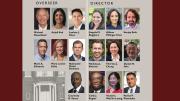The curator of the Lee Family Hall of Athletic History, at the Murr Center, is Warren M. "Renny" Little '55, a track man in his youth. He indefatigably gathers Crimson sports memorabilia for the Athletic Department, from ancient baseballs to the early postcards of the Stadium that help illustrate the article on page 42. He recently had trophies restored and polished, among them these five.
 | Rose Bowl Trophy. The 1919 football season climaxed in Harvard's first and only Rose Bowl invitation. The powerhouse squad went west in a private railroad car, arriving in Pasadena in six days. Despite what the Crimson felt was the excessive heat (70 degrees F), they triumphed over the Oregon Webfoots, 7-6. |
 | Harvard-Army Friendship Cup. The football team visited West Point for the first time in 1895, and the manager requested a guarantee to cover travel expenses. Army then had no athletic association, and so the officers and cadets took up a collection to grant the request. The Crimson won, in a downpour, 4-0. Later, when it discovered how the guarantee was raised, Harvard returned the money. In appreciation, the officers and cadets sent Harvard this fine cup, emblazoned with "Veritas" and eagles. |
 | "Through Sport United." In the summer of 1934, the baseball team went on a good-will trip to Hawaii and Japan. In Hawaii the squad won six games against local colleges; in Japan it lost six. The Waseda University winners gave this cup to the losers to mark their successful visit. |
 | The first IC4A Cup. To stimulate interest in track, the Intercollegiate Association of Amateur Athletics of America (IC4A), formed in 1876, offered a cup to be placed in competition for 14 years. Wing-footed sprinter Evert J. Wendell, A.B. 1882, led Harvard track to a golden age and this silver cup. |
 | Harvard-Yale Cup. In 1891 the archrivals organized an annual dual track meet and raised funds from graduates for a silver cup, which would go to the annual winner for nine years and then become the permanent possession of the college that had won it most often. Harvard got to keep the cup. Yale won the next one. |





